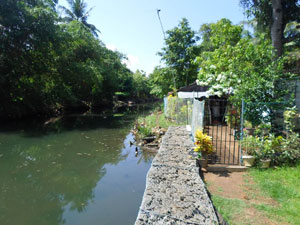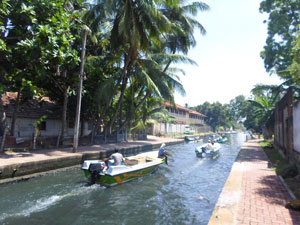News
Hamilton Canal: A lifeblood of travel and transport that flows unnoticed

Homes have been built along the banks
In Sri Lanka, irrigation channels are complex ones as their engineering technology is considered to be highly advanced compared with other countries.
In the past, canals in the west were connected to lagoons and rivers, as they were used for travel and transport goods.
Negombo is a tourist hub, and is a pivotal junction only a few kilometres from Katunayake International Airport.
The Hamilton Canal in Negombo, which was once the main port of the Sinhala kingdom, unfolds history, revealing activities which, at one time, seemed beyond the limits of human endeavour.
H.A.D. Joseph, 55, of Alwiswatta Alakanda Pamunugama says, “Still people remember the great leader, Prime Minister Sirimavo Bandaranaike who unveiled the plaque in 1975, to develop this canal. But our people are still in the same boat. We earnestly ask the authorities to dig the canal a few feet deep so that, fishing boats could travel with their bottoms unharmed. The other thing is, between 10 am and 11 am, factories and people dump waste into the canal, thereby polluting the canal. Why can’t politicians look into this? There was a boat used by ‘Lak Danav’ to clean the canal daily. But now, even that does not come this way.”
According to the Sri Lanka Land Reclamation Development Corporation, they are going to develop the canal in 2 stages. First stage from Maha Oya to Negombo- 9 km. Second stage from Kelaniya to Negombo- 25 km. They have already developed it from Hekiththa to Pinwatta, spending about Rs 400 million.

Canal banks on either side should be 20-ft wide, but in some places it is 10-ft wide or only 3-ft .
However, one wonders at this kind of development when one sees people settled along the banks of the Hamilton Canal near the Ettukala Bridge.
The canal banks on either side should be 20-ft wide, but in some places it is 10-ft wide or only 3-ft . Some affluent people have moved their boundary fences towards the canal, encroaching on crown land.
On the other side, poor people have built slums on the banks, even filling it with earth a few feet into the canal. Antoney Vilose, 46, living at Ettukal says, “There are about 50 families living here. We have been living here for a long time. We can move 10 ft away from the canal. We were in the dark for about 15 years because there is no way to lay the wires. Only Samurdhi officers mediated and helped us get electricity through the village.” Nimali Fernando, 34, a mother of three, one of whom is disabled, says, “We have no place to go.We have been here since our birth. We ask the authorities to build the bund.”
M.P. Tissera, 62, of Palangathurai, a retired CGR officer says, “During our childhood we bathed and swam in this canal. How nice it was then to see its bed with white sand. People are longing to see the canal once again in all its past glory, attracting both local and foreign visitors, as another novel investment to boost our economy.

H.A.D. Joseph, 55, of Alwiswatta Alakanda Pamunugama


